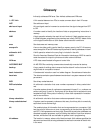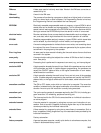99
Glossary
*DM Indirectly addressed DM area. See indirect address and DM area.
1:1 PC Link A link created between two PCs to create common data in their LR areas.
ACP See add count input.
add count input An input signal used to increment a counter when the signal changes from OFF
to ON.
address A number used to identify the location of data or programming instructions in
memory.
AND A logic operation whereby the result is true if and only if both premises are true.
In ladder-diagram programming the premises are usually ON/OFF states of bits
or the logical combination of such states called execution conditions.
area See data area and memory area.
area prefix A one or two letter prefix used to identify a memory area in the PC. All memory
areas except the IR and SR areas require prefixes to identify addresses in them.
arithmetic shift A shift operation wherein the carry flag is included in the shift.
ASCII Short for American Standard Code for Information Interchange. ASCII is used to
code characters for output to printers and other external devices.
AR Area A PC data area allocated to flags and control bits.
AUTOEXEC.BAT An MS DOS file containing commands automatically executed at startup.
back-up A copy made of existing data to ensure that the data will not be lost even if the
original data is corrupted or erased.
basic instruction A fundamental instruction used in a ladder diagram. See advanced instruction.
baud rate The data transmission speed between two devices in a system measured in bits
per second.
BCD See binary-coded decimal.
BCD calculation An arithmetic calculation that uses numbers expressed in binary-coded deci-
mal.
binary A number system where all numbers are expressed in base 2, i.e., numbers are
written using only 0’s and 1’s. Each group of four binary bits is equivalent to one
hexadecimal digit. Binary data in memory is thus often expressed in hexadeci-
mal for convenience.
binary calculation An arithmetic calculation that uses numbers expressed in binary.
binary-coded decimal A system used to represent numbers so that every four binary bits is numerically
equivalent to one decimal digit.
bit The smallest piece of information that can be represented on a computer. A bit
has the value of either zero or one, corresponding to the electrical signals ON
and OFF. A bit represents one binary digit. Some bits at particular addresses are
allocated to special purposes, such as holding the status of input from external
devices, while other bits are available for general use in programming.
bit address The location in memory where a bit of data is stored. A bit address specifies the
data area and word that is being addressed as well as the number of the bit with-
in the word.


















